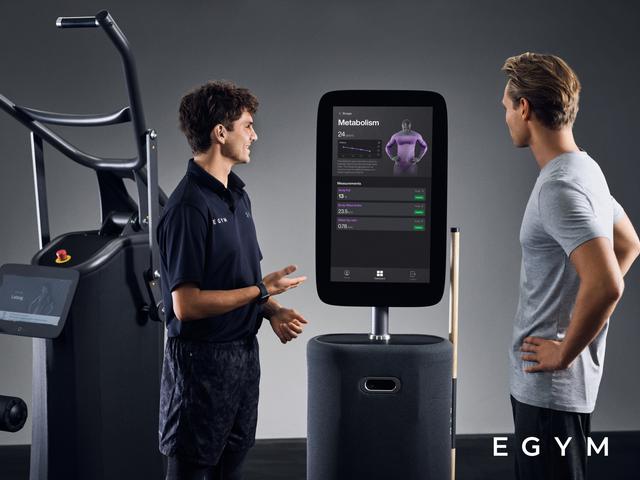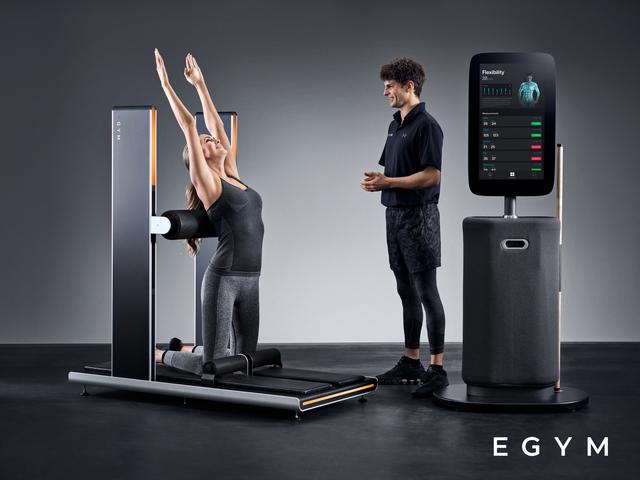Welcome to the Fitness Hub
The Centerpiece of Your Connected Training Floor
How Can This Online Guide Help?
This online guide explains how to measure member fitness and flexibility using the EGYM Fitness Hub as part of your onboarding workflow.
It also provides training recommendations for members once they have completed onboarding.
Let's get started!

What is the Fitness Hub?
Designed for gym operators, trainers, and members, the EGYM Fitness Hub enables quick onboarding, optimal member care, and continuous motivation on the training floor of the future.

What are the Benefits of the Fitness Hub?
- Efficient and touchless onboarding with automatic adjustment of all EGYM machines based on measurement results
- Integration with body composition scales from leading manufacturers
- Simple and precise measurement of member fitness and flexibility, with detection of incorrect movements
- Motivating and intuitive progress visualization using EGYM BioAge
Body Measurement Basics
What does the Fitness Hub Measure?
The flexibility of the following muscle groups can be measured using Fitness Hub:
Where and How Should I Stand?
After selecting a flexibility test, follow the instructions on the screen and adopt the following basic stance to start the test:
- Stand upright in the center of the frame approx. 2 meters away from the camera with your feet shoulder width apart.
- Ensure that your hips and shoulders are parallel to the screen (not rotated).
- Both feet must be positioned at the same distance to the screen.
- Your whole body must be upright.
The Fitness Hub will prompt you to make changes to this basic stance during the tests for each muscle group. Simply follow the instructions on the screen. Any incorrect movements are automatically detected, and the affected joints are labeled in red.
The Fitness Hub will also explain on screen how to correct your movements.
Lateral Torso Test
Measured Muscles
The main muscles measured during the lateral torso test are:
- Latissimus dorsi
- Quadratus lumborum
- Internal and external obliques
Lifestyle Impact
The lateral torso muscles bend, rotate and stabilize your core. Muscle stiffness in this area or limited lateral range of motion can cause lumbar spine pain. It can also restrict the ability of the diaphragm and the chest to expand, inhibiting normal breathing.
Training Recommendations
Smart Flex: The Smart Flex Lat Flex machine allows you to lengthen your lateral torso muscles safely and effectively. Regaining a typical range of motion and reducing the muscle tension reduces the pressure on your spine and frees your breathing muscles.
No equipment required: Lat stretch side bending
Additional Instructions
- Hold the flexibility stick horizontally in both hands as shown in the video.
- Stand upright and bring the stick over your head with extended arms.
- Bend your upper body to the left as far as possible.
- Note: Make sure that your upper body does not bend forward/backward and that your shoulders and hips remain parallel to the screen.
- Maintain this position until the Fitness Hub confirms that measurement has been completed.
- Return to the neutral position when prompted to do so.
- Repeat steps 1-6 for the right side as instructed on the screen.
Video Demonstration
Neck Test
Measured Muscles
The main muscles measured during the neck test are:
- Scalene
- Upper trapezius
- Levator scapulae
- Suboccipitales
Lifestyle Impact
The lateral neck muscles stabilize your head and facilitate head movement. Periods of prolonged stress or sitting still for long periods, for example at a computer, can decrease flexibility. This can lead to headaches, muscle pain due to tension, jaw clenching or pain in the cervical spine.
Training Recommendations
Smart Flex: Work out with the Smart Flex Neck machine to lengthen your lateral neck muscles. The reduced muscle tension can help to relax the cervical spine region.
No equipment required: Lateral neck flexion stretch
Additional Instructions
- Hold the flexibility stick vertically to the ground in one hand as shown in the video. This will help you maintain balance.
- Tilt your head to the left as far as possible.
- Note: Make sure that your upper body does not bend to the left/right and that your shoulders and hips remain parallel to the screen.
- Maintain this position until the Fitness Hub confirms that measurement has been completed.
- Return to the neutral position when prompted to do so.
- Repeat steps 1-5 for the right side as instructed on the screen.
Video Demonstration
Hip Test
Measured Muscles
The muscle groups measured during the hip flexibility test are:
Primary Muscles
- Musculus Iliopsoas
- Musculus Psoas Major
- Musculus Psoas Minor
- Musculus iliacus
- Rectus femoris
Secondary Muscles
- Quadriceps femoris
- Rectus abdominis
Lifestyle Impact
The hip flexor muscles control your posture during everyday movements such as walking, running and climbing stairs. Sitting for long periods in a contracted position causes the muscles to shorten. This can negatively affect your posture and ultimately lead to lumbar spine pain.
Training Recommendations
Smart Flex: Exercising with the Smart Flex Hip machine will lengthen your hip flexor muscles. This will help you maintain an upright posture and relax the lower back area.
No equipment required: Hip flexor stretch
Additional Instructions
- Stand parallel to the screen and align your feet with the green markers as shown in the video.
- Turn 90 degrees to the left side as shown in the video.
- Follow the instructions on the screen for correct positioning of your feet.
- Bend your upper body backwards as far as possible. Make sure to keep your hips straight and not turned in.
- Maintain this position until the Fitness Hub confirms that measurement has been completed.
- Repeat steps 3-5 for the other side as instructed on the screen.
Pro tip:
To ensure your hips are kept straight, tighten your glute and abdominal muscles.
Video Demonstration
Chest Test
Measured Muscles
The muscle groups measured during the chest flexibility test are:
Primary Muscles
Chest muscles
- m. pectoralis major
- m. pectoralis minor
Abdominal Muscles
- m. rectus abdominis
Secondary Muscles
Abdominal Muscles
- m. obliquus externus abdominis
- obliquus internus abdominis
- transversus abdominis
Diaphragm
Rib elevator
- m. levatores costarum
Lifestyle Impact
The chest muscles are responsible for movement in the upper body and also to stabilize the shoulder joint. A curved posture, e.g. due to sedentary office work, leads to a shortening of these muscles in the long term, which can lead to pain in the cervical spine and shoulder problems.
Training Recommendations
Smart Flex: Exercising with the Smart Flex Chest will improve your chest and respiratory support muscles flexibility. The chest muscles will lengthen which leads to a healthier posture and ultimately can reduce pain in the back and neck.
No equipment required: Chest stretch standing against the wall.
Additional Instructions
- Hold the flexibility stick horizontally in both hands as shown in the video.
- Stand upright and shoulder-width apart and bring the stick over your head with extended arms.
- Now stretch your arms as far back as possible.
- Maintain this position until the Fitness Hub confirms that measurement has been completed.
Video Demonstration
Hamstring Test
Measured Muscles
The main muscles measured during the hamstring test are the ischiocrural muscles:
- Musculus Ischiocrurale
- Musculus biceps femoris
- Musculus semimembranosus
- Musculus semitendinosus
Lifestyle Impact
The muscles of the back of the thigh, also called ischiocrural muscles (or "hamstrings"), are responsible for flexion in the knee joint and extension in the hip joint. Unfortunately, this muscle group tends to shorten due to incorrect postural patterns that occur in everyday life, such as prolonged sitting or lack of exercise. This shortening can affect the entire fascial chain of the back of the body and promote back pain. In extreme cases, it can even cause herniated discs.
Training Recommendations
Smart Flex: The muscle length training using our Smart Flex devices can improve the mobility of the hamstrings. Recommended exercises are the Smart Flex Calf and Smart Flex Split.
Additional Instructions
- Stand parallel to the screen and align your feet with the markers as shown in the video.
- Turn 90 degrees to the left side, as shown in the video.
- Now follow the instructions on the Fitness Hub for correct foot positioning.
- Bend forward as far as you can with your upper body, making sure your back is straight and your knees are straight, not bent.
- Maintain this position until the Fitness Hub confirms that measurement has been completed.
- Repeat steps 3-5 for the right side as instructed on the screen.
Pro tip:
For an increased stretch of the hamstrings (leg flexors), flex your toes towards your shins.
